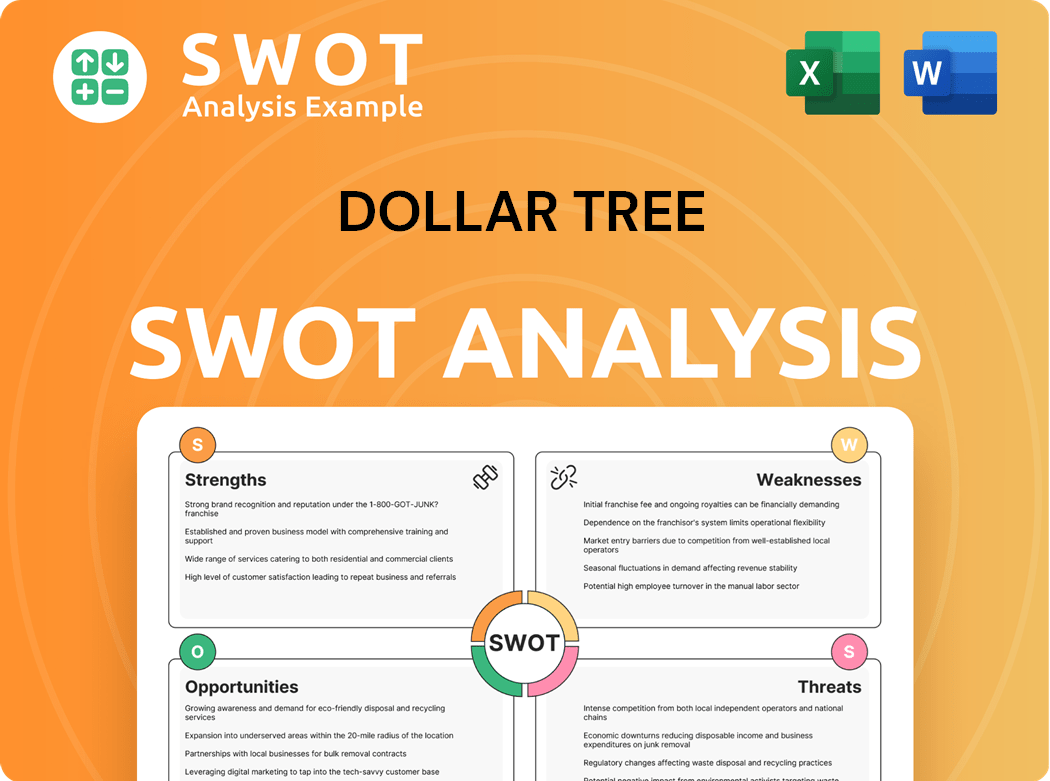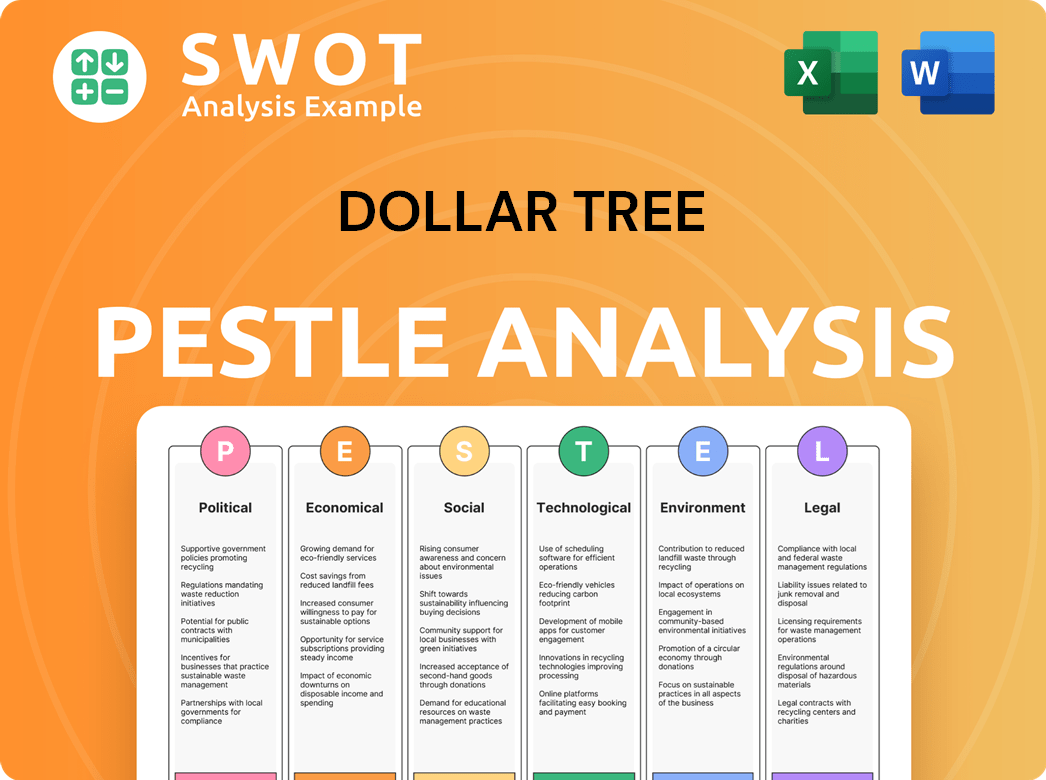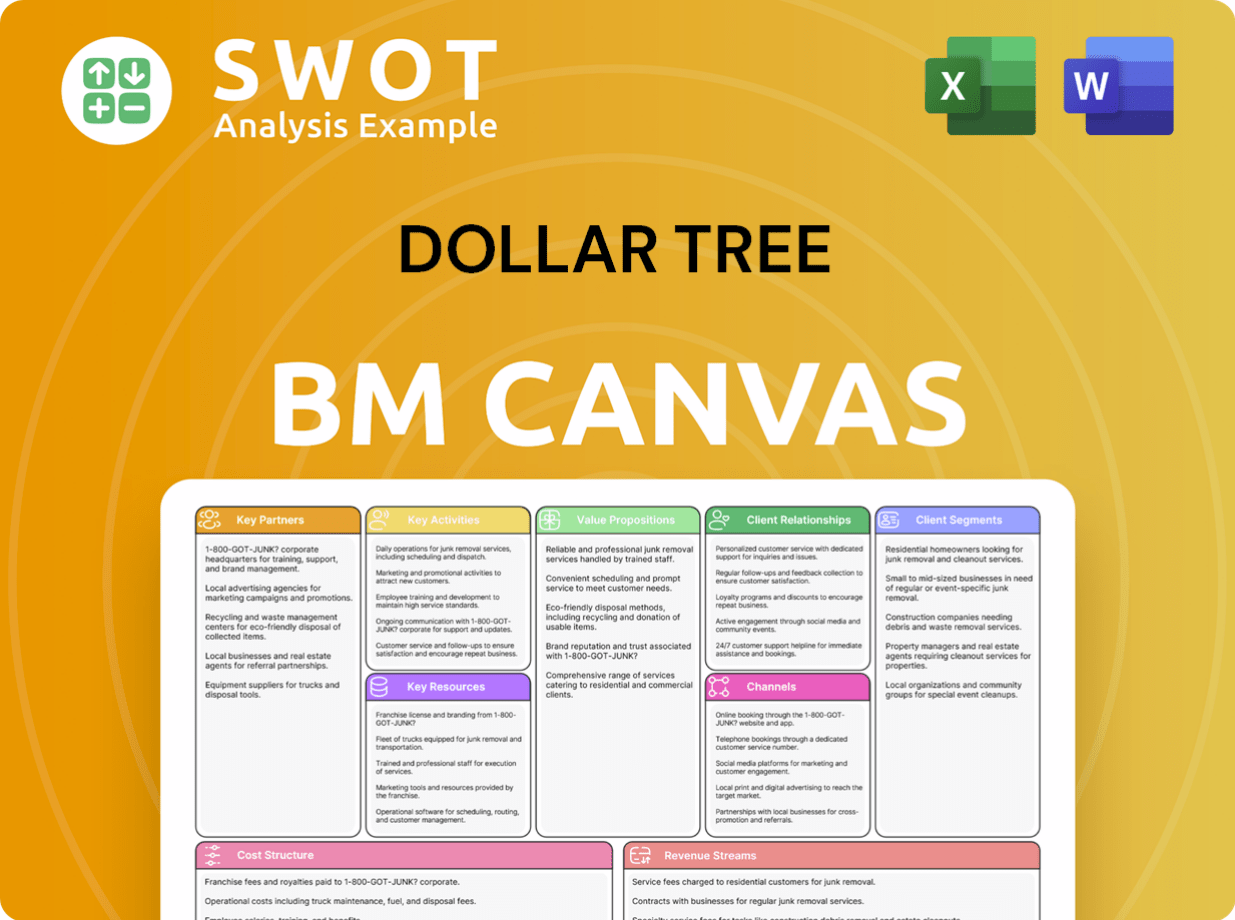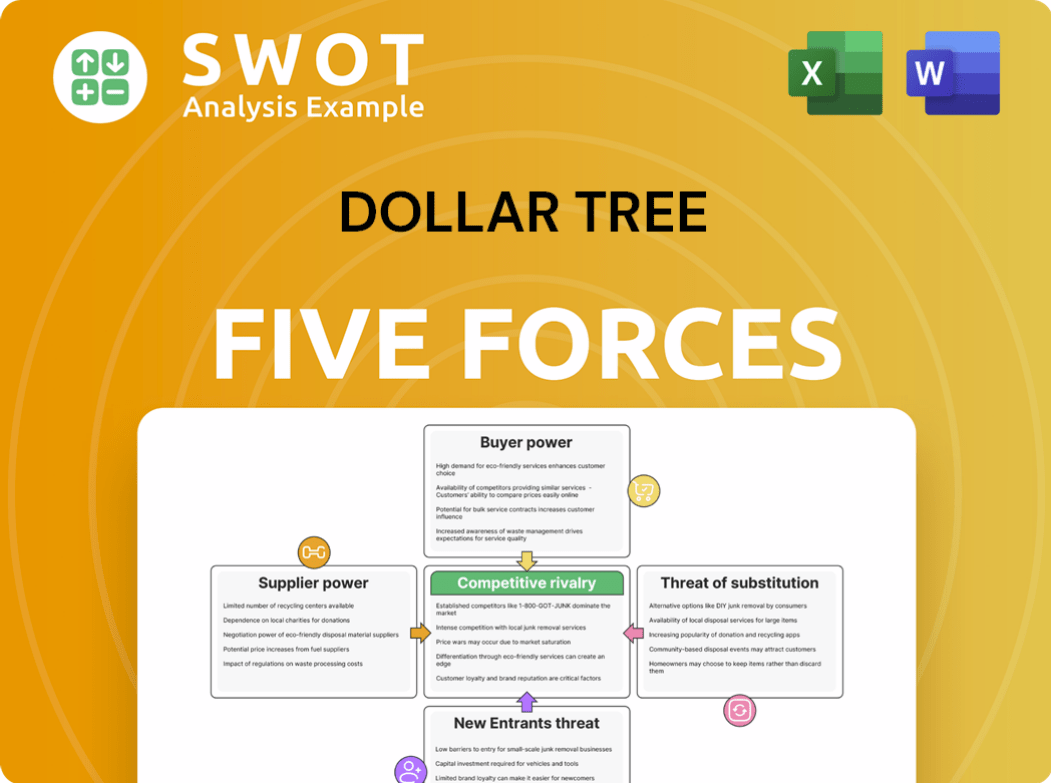Dollar Tree Bundle
How is Dollar Tree Adapting to Thrive in Today's Retail Landscape?
Founded in 1986, Dollar Tree revolutionized discount retail with its simple $1 price point. But how has this strategy held up against inflation and fierce competition? This analysis dives deep into the evolution of Dollar Tree's sales and marketing strategies, revealing its moves to stay ahead.

From its initial fixed-price model to its current multi-price format, Dollar Tree's Dollar Tree SWOT Analysis reveals a dynamic approach to the market. Explore the Dollar Tree sales strategy, Dollar Tree marketing strategy, and Dollar Tree business model and uncover the secrets behind its ability to attract customers and maintain its competitive advantage. This report examines the Dollar Tree marketing plan and pricing strategy to understand how the company navigates challenges and capitalizes on opportunities, including Dollar Tree's marketing campaigns examples and its online marketing strategy.
How Does Dollar Tree Reach Its Customers?
The core of the Growth Strategy of Dollar Tree revolves around its extensive network of physical stores. As of February 1, 2025, the company operated a massive footprint of approximately 16,500 stores across 48 states and five Canadian provinces under the Dollar Tree, Family Dollar, and Dollar Tree Canada banners. This widespread presence is a key element of its Dollar Tree sales strategy, ensuring accessibility for a broad customer base.
The company strategically adjusts its store portfolio to enhance profitability. In the first half of fiscal 2024, Dollar Tree announced plans to close about 600 underperforming Family Dollar stores, with additional closures planned in the following years. Simultaneously, Dollar Tree continues its expansion, planning to open over 1,300 new stores in fiscal year 2024 across both banners. This approach is crucial for maintaining a competitive advantage in the discount retail sector.
Dollar Tree is also strategically adopting e-commerce. E-commerce is considered crucial in 2024 for dollar store businesses to attract a broader customer base and complement in-store experiences. Digital Commerce 360 projects Dollar Tree's online sales to reach $555.19 million in 2024. The multi-price point format, implemented in roughly 2,900 Dollar Tree stores, is another strategic shift designed to broaden product offerings and customer appeal, influencing the Dollar Tree marketing strategy.
Dollar Tree's primary sales channel is its vast network of physical stores, totaling approximately 16,500 locations as of early 2025. The company consistently opens new stores while strategically closing underperforming ones to optimize its portfolio. In fiscal year 2024, over 1,300 new stores were planned to open.
Dollar Tree is expanding its online presence to complement its in-store experience. E-commerce is considered crucial in 2024 for dollar store businesses to attract a broader customer base. Digital Commerce 360 projects online sales to reach $555.19 million in 2024.
Dollar Tree's approach involves a blend of physical and digital sales strategies. This includes store optimization, new store openings, and e-commerce expansion to enhance its market share analysis. The company's Dollar Tree business model is evolving to meet changing consumer demands and maintain its competitive advantage.
- Store Closures and Openings: Closing underperforming stores while opening new ones.
- E-commerce Growth: Expanding online sales to complement in-store experiences.
- Multi-Price Point Format: Implementing the multi-price point format to broaden product offerings.
- Acquisitions: Acquiring leases from other retailers to expand its store network.
Dollar Tree SWOT Analysis
- Complete SWOT Breakdown
- Fully Customizable
- Editable in Excel & Word
- Professional Formatting
- Investor-Ready Format

What Marketing Tactics Does Dollar Tree Use?
The marketing tactics of the company focus on value, affordability, and a blend of digital and traditional strategies to build brand awareness and drive sales. The company leverages its social media presence and digital marketing to broaden its reach and attract a wider customer base. The company's approach includes data-driven marketing, customer segmentation, and adapting to changing consumer trends.
The company employs a comprehensive marketing strategy that includes a strong social media presence and a customer loyalty program. The company's marketing plan is designed to engage customers on a personalized level and foster loyalty. The company also focuses on optimizing inventory management and understanding consumer behavior through data analytics to meet diverse customer needs.
The company's marketing mix is evolving to address changing consumer trends and competitive pressures. The introduction of the multi-price point strategy, offering items up to $7, is a significant innovation. This strategic adjustment aims to enhance the shopping experience and attract more customers.
The company actively uses social media platforms to showcase products and promotions. The company has a combined following of approximately 3.2 million across platforms like Facebook, Instagram, and TikTok. Engagement rates vary, with 4.3% on Facebook, 3.7% on Instagram, and 5.2% on TikTok.
The company's loyalty program has around 1.5 million active members. Members receive personalized promotional offers. The average member spends $85 per quarter and receives 10-15% off through member-exclusive discounts. This is part of the company's efforts to build customer loyalty.
The company has introduced a multi-price point strategy in its stores. This includes items priced up to $7. This strategic move aims to diversify product offerings and appeal to a wider range of consumers. This strategy is part of the company's overall business model.
The company emphasizes its value proposition to meet consumer demand, especially in uncertain economic times. The company focuses on providing affordable products. This is a key aspect of the company's marketing strategy.
The company is adapting to sustainability trends. It offers eco-friendly products and reduces packaging waste. This aligns with consumer preferences for environmentally conscious shopping. This is another element of the company's marketing strategy.
The company uses data analytics to optimize inventory management. It also uses data to understand consumer behavior. This helps the company meet diverse customer needs. Data-driven insights are used for the company's marketing campaigns.
The company's marketing strategy is built on several key tactics.
- Social media marketing to increase brand awareness and customer engagement.
- Customer loyalty programs to foster repeat purchases and personalized offers.
- Multi-price point strategy to attract a wider customer base.
- Emphasis on value and affordability to meet consumer needs.
- Sustainability initiatives to align with consumer preferences.
- Data analytics to optimize inventory and understand consumer behavior.
Dollar Tree PESTLE Analysis
- Covers All 6 PESTLE Categories
- No Research Needed – Save Hours of Work
- Built by Experts, Trusted by Consultants
- Instant Download, Ready to Use
- 100% Editable, Fully Customizable

How Is Dollar Tree Positioned in the Market?
The brand positioning of the [Company Name] centers on providing exceptional value and a unique 'treasure hunt' shopping experience. This strategy differentiates it from competitors by offering a wide range of merchandise, primarily priced at $1.25 or less. The core message emphasizes affordability and discovery, attracting budget-conscious shoppers looking for both essential and discretionary items at low prices. This value pricing strategy remains a significant competitive advantage.
However, the brand is evolving with the introduction of a multi-price point format, allowing items to be priced up to $7. This expansion aims to broaden its appeal beyond solely low-income consumers, attracting middle- and higher-income shoppers who also seek value. This strategic shift is designed to enhance the shopping experience and diversify the product range, including more consumables and a wider assortment of discretionary items. Despite this expansion, the company continues to emphasize value as the most important reason for purchase.
Brand consistency across all channels is crucial, and the company is working to ensure its updated offerings align with consumer expectations of value. The company faces the challenge of maintaining its core 'dollar store' identity while expanding its price points and product selection. The company is refining its offerings and optimizing its store portfolio in response to shifts in consumer sentiment and competitive threats from retailers like Dollar General, Walmart, and Target. Focusing on improving brand trust, enhancing product offerings, and refining e-commerce are also key to differentiating itself and strengthening its appeal, particularly in rural and underserved markets. For more insights into the company's financial performance, consider exploring Owners & Shareholders of Dollar Tree.
The core of [Company Name]'s brand positioning is its value proposition. This is built on offering products at extremely low prices, primarily $1.25 or less. This strategy is designed to attract a broad customer base, including those who are price-sensitive and looking for deals.
Initially, the primary target market consisted of low-income consumers. However, the company is expanding its reach to include middle- and higher-income shoppers. This expansion is supported by the multi-price point strategy, which allows for a wider range of products and price points.
The company differentiates itself through its pricing strategy and the unique 'treasure hunt' shopping experience. This approach contrasts with competitors like Walmart and Target. The company focuses on offering a diverse product range at significantly lower prices.
The brand message emphasizes affordability, value, and the excitement of discovery. Marketing campaigns and in-store promotions highlight these aspects. Communication strategies are tailored to resonate with a diverse customer base, emphasizing the benefits of low prices and a wide product selection.
The company faces challenges in maintaining its brand identity while expanding its offerings. To address this, the company focuses on several key strategies.
- Refining product offerings to meet evolving consumer needs.
- Optimizing the store portfolio to enhance the shopping experience.
- Improving brand trust and enhancing e-commerce capabilities.
- Strengthening its appeal in rural and underserved markets through targeted marketing and product selections.
Dollar Tree Business Model Canvas
- Complete 9-Block Business Model Canvas
- Effortlessly Communicate Your Business Strategy
- Investor-Ready BMC Format
- 100% Editable and Customizable
- Clear and Structured Layout

What Are Dollar Tree’s Most Notable Campaigns?
The sales and marketing strategy of Dollar Tree centers on key initiatives designed to enhance the shopping experience and drive growth. While specific, named marketing campaigns are not heavily publicized in recent reports, the company's strategic actions, particularly in 2024 and 2025, serve as crucial sales and marketing efforts. These efforts are focused on evolving the brand's physical presence and product offerings to meet consumer demands and foster long-term expansion. The company's approach is heavily influenced by its Growth Strategy of Dollar Tree.
One of the primary strategies is the expansion of the multi-price format, known as Dollar Tree 3.0. This involves converting stores to include price points up to $7, aiming to attract a broader customer base and increase sales. Another significant aspect is portfolio optimization, which includes closing underperforming Family Dollar stores to streamline operations and focus resources. These efforts reflect a dynamic approach to adapt to market changes and enhance profitability.
Furthermore, the acquisition and reopening of leases from the bankrupt 99 Cents Only Stores chain in spring 2024 highlight a growth-oriented strategy. This rapid expansion allows the company to quickly increase its footprint and market presence in strategic regions, demonstrating a proactive approach to market opportunities. These initiatives demonstrate a focus on evolving its physical presence and product offerings to meet consumer demands and drive long-term growth.
The multi-price format rollout, Dollar Tree 3.0, is a key initiative. By the end of fiscal 2024, approximately 2,900 stores were converted or opened with expanded price points. This strategy aims to increase sales by offering a more diversified product range.
The company is optimizing its portfolio by closing underperforming Family Dollar stores. In the first half of fiscal 2024, around 600 Family Dollar stores were slated for closure. This strategic move aims to streamline operations and focus on more viable locations.
Dollar Tree acquired leases from the bankrupt 99 Cents Only Stores chain. The company purchased 170 leases and has already reopened 158 of these as Dollar Tree stores. This expansion allows the company to increase its footprint in strategic regions.
Conversions with the new multi-price format showed strong results. Q1 fiscal 2024 conversions experienced a 5.1% comparable store sales growth. Consumables within these stores grew by 6.7%, demonstrating the effectiveness of the new format.
Dollar Tree aims to attract a broader customer base through its multi-price format. This strategy allows the company to cater to a wider range of consumer needs and preferences. The expansion into different price points helps capture a larger segment of the market.
Although specific advertising campaigns are not extensively publicized, the rollout of the multi-price format serves as a significant marketing effort. The acquisition and reopening of leases also act as a form of marketing by increasing visibility. These initiatives are central to the Dollar Tree marketing plan.
Dollar Tree attracts customers by offering a diverse product range at competitive prices. The multi-price format allows for a wider variety of products, increasing appeal. Strategic store locations and acquisitions also boost customer accessibility.
In-store promotions are a key part of the strategy, especially with the expanded product range. The multi-price format allows for various promotional strategies. These promotions attract customers and drive sales.
The pricing strategy is central to Dollar Tree's competitive advantage. The multi-price format allows for flexible pricing, catering to different product categories. This strategy supports Dollar Tree's revenue model.
The company's expansion strategy involves both organic growth and strategic acquisitions. The opening of new stores and the acquisition of leases from competitors are key components. This strategy helps increase market share.
Dollar Tree Porter's Five Forces Analysis
- Covers All 5 Competitive Forces in Detail
- Structured for Consultants, Students, and Founders
- 100% Editable in Microsoft Word & Excel
- Instant Digital Download – Use Immediately
- Compatible with Mac & PC – Fully Unlocked

Related Blogs
- What are Mission Vision & Core Values of Dollar Tree Company?
- What is Competitive Landscape of Dollar Tree Company?
- What is Growth Strategy and Future Prospects of Dollar Tree Company?
- How Does Dollar Tree Company Work?
- What is Brief History of Dollar Tree Company?
- Who Owns Dollar Tree Company?
- What is Customer Demographics and Target Market of Dollar Tree Company?
Disclaimer
All information, articles, and product details provided on this website are for general informational and educational purposes only. We do not claim any ownership over, nor do we intend to infringe upon, any trademarks, copyrights, logos, brand names, or other intellectual property mentioned or depicted on this site. Such intellectual property remains the property of its respective owners, and any references here are made solely for identification or informational purposes, without implying any affiliation, endorsement, or partnership.
We make no representations or warranties, express or implied, regarding the accuracy, completeness, or suitability of any content or products presented. Nothing on this website should be construed as legal, tax, investment, financial, medical, or other professional advice. In addition, no part of this site—including articles or product references—constitutes a solicitation, recommendation, endorsement, advertisement, or offer to buy or sell any securities, franchises, or other financial instruments, particularly in jurisdictions where such activity would be unlawful.
All content is of a general nature and may not address the specific circumstances of any individual or entity. It is not a substitute for professional advice or services. Any actions you take based on the information provided here are strictly at your own risk. You accept full responsibility for any decisions or outcomes arising from your use of this website and agree to release us from any liability in connection with your use of, or reliance upon, the content or products found herein.